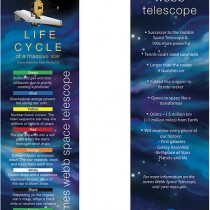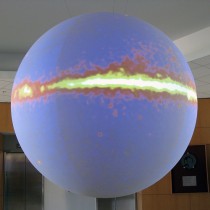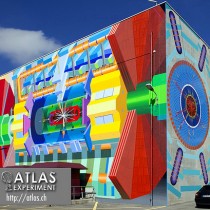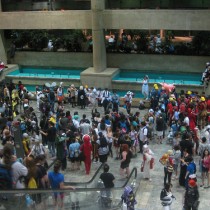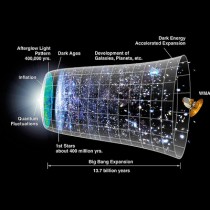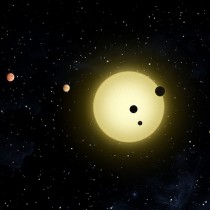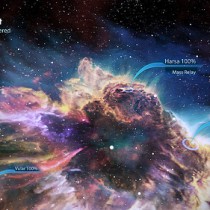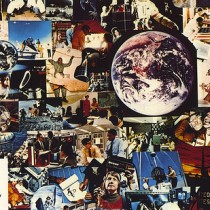What is a Galaxy?
- By Koji Mukai
- September 17, 2012
- Comments Off on What is a Galaxy?
“Galaxy,” Defined — when I came across a paper with this title while browsing a recent issue of Astronomical Journal, I was intrigued. You would think that such a widely known term, one so fundamental to modern astronomy, would have been defined a long time ago. But then, sometimes the … Continue Reading →
Try It At Home: Life Cycle of a Massive Star Activity
- By Maggie Masetti
- September 13, 2012
- Comments Off on Try It At Home: Life Cycle of a Massive Star Activity
Stars and planets form in the dark, inside vast, cold clouds of gas and dust. The James Webb Space Telescope’s large mirror and infrared sensitivity will let astronomers peer inside dusty knots where the youngest stars and planets are forming. The Webb telescope project has developed a bookmark and an … Continue Reading →
Science on a Sphere
- By Maggie Masetti
- August 27, 2012
- 3 Comments
One of the things you can see if you visit NASA Goddard (or dozens of museums and other institutions worldwide) is a 68-inch sphere on which moving images are projected – it’s called “Science on a Sphere.” Goddard has one on display in its Visitor Center, and there’s also a … Continue Reading →
Who cares about gravity?
- By Umberto Cannella
- August 22, 2012
- 1 Comment
Numerical simulation of two merging black holes performed by the Albert Einstein Institute in Germany: what this rendition shows through colors is the degree of perturbation of the spacetime fabric, the so-called gravitational waves. Credit: Werner Benger Who cares about gravity? Shouldn’t this be a settled question by now? This … Continue Reading →
Relating Science and Science-Fiction at Otakon
- By Jillian Brown
- August 20, 2012
- 1 Comment
During the last weekend of July Baltimore was host to about thirty-two thousand very interesting people (in addition to the devoted sports fans at Camden Yard and M&T Bank Stadium). Nerds, geeks, fans and enthusiasts alike gathered at the Baltimore Convention Center for Otakon 2012, the nineteenth-annual Baltimore convention devoted … Continue Reading →
Biggest Bang
- By Alexe Helmke
- August 9, 2012
- Comments Off on Biggest Bang
Welcome to the -EST blog! Here we’ll chat about some of the awesome astronomical superlatives that exist in our universe – biggest, smallest, brightest, coldest, densest, and whatever else we come up with. As this is my first -EST blog, I thought it would make sense to start with something … Continue Reading →
Anatomy of an Exosolar System
- By Jillian Brown
- August 3, 2012
- Comments Off on Anatomy of an Exosolar System
A good chunk of the exoplanets that we’ve detected so far are huge, Jupiter-sized and larger. A lot of them are orbiting their stars at very short distances – it might seem strange to think that planets bigger than Jupiter are orbiting their stars closer than Mercury orbits the Sun, … Continue Reading →
Exploring the Galaxy with Mass Effect 3
- By Sara Mitchell
- July 31, 2012
- 1 Comment
The fictional Kite’s Nest from Mass Effect 3 Image provided by EA/BioWare The first time I caught a glimpse of the astronomical imagery in the Mass Effect video games, I was blown away by how realistic everything looked. While the plot of the games is solidly science fiction, the setting … Continue Reading →
Exoplanets, Tech, and Space Travel
- By Jillian Brown
- July 24, 2012
- 3 Comments
Fomalhaut + Fomalhaut b; courtesy of NASA, ESA, UC Berkeley, NASA GSFC, Lawrence Livermore National Laboratory, and NASA JPL-Caltech) For a lot of people, exoplanets are some of the most exciting discoveries in current astronomy. The first exoplanets were detected in 1992 orbiting the pulsar PSR B1257+12, all three of … Continue Reading →
Want to get a postcard from Blueshift?
- By Maggie Masetti
- July 20, 2012
- 2 Comments
Guess what! We’ve turned 5! NASA Blueshift released its first podcast in 2007 (we’d like to think that our podcasts have vastly improved since those early episodes), and we’ve steadily expanded to blogging, tweeting, and keeping up with social media to find the best ways to bring the Universe closer … Continue Reading →



